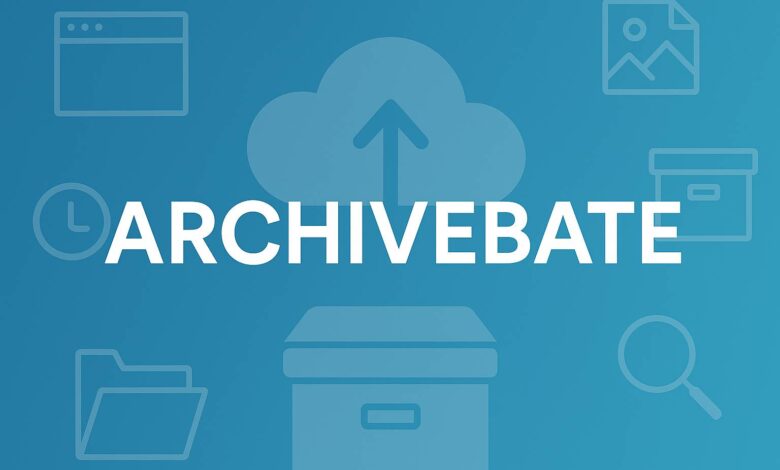Archivebate – Complete Guide for Beginners and Experts

In the modern age of the internet, the preservation of digital content has become as important as creating it. Archivebate is a platform designed to help users store, manage, and revisit their favorite online materials in an organized, accessible way. Unlike temporary bookmarks or scattered file storage, Archivebate serves as a centralized system where users can save, archive, and later browse their selected media. Whether it’s a video, image, article, or document, the idea behind Archivebate is to make sure content is never lost due to website removals, broken links, or platform shutdowns. In this detailed guide, we’ll explore what Archivebate is, how it works, and how it can be used effectively for both personal and professional needs.
What is Archivebate?
Archivebate is an online archiving and bookmarking service that specializes in long-term digital preservation. While many platforms like web browsers offer bookmark features, Archivebate extends the functionality by allowing rich metadata tagging, custom organization, and offline content storage. It is widely used by researchers, archivists, educators, journalists, and enthusiasts who want to retain content that might otherwise disappear over time. The primary advantage of Archivebate is that it does not just save the link—it stores the actual media or webpage in a permanent, retrievable format.
Key Features of Archivebate
When discussing archivebate, it’s important to highlight its standout features that differentiate it from basic bookmarking tools:
- Permanent Storage – Content saved in Archivebate is backed up to prevent loss due to link rot or deletion.
- Advanced Tagging – Users can tag archived items with keywords, making retrieval faster and more organized.
- Privacy Controls – Content can be stored privately, shared with select users, or made publicly accessible.
- Multiple Media Support – Videos, images, audio files, and PDFs can all be archived.
- Search Functionality – Built-in search tools allow quick location of archived materials using tags, titles, or descriptions.
Why Archivebate is Important
The internet is constantly evolving, and content often disappears unexpectedly. Articles may be removed, videos may be deleted, and entire websites can go offline. Archivebate offers a safety net for individuals and organizations who rely on stable access to specific online resources. For example:
- Researchers can save critical data for long-term studies.
- Journalists can preserve evidence from online sources before it’s taken down.
- Content Creators can maintain a personal archive of their work and inspirations.
By ensuring that these resources remain accessible, Archivebate plays a significant role in maintaining the continuity and reliability of digital information.
How to Use Archivebate – Step-by-Step
If you’re new to archivebate, here’s a simplified guide to getting started:
- Create an Account
Visit the official Archivebate website and register for a free or premium account. - Install Browser Extensions
Archivebate often provides browser add-ons for quick archiving without visiting the main site. - Save Content
When you find content you want to preserve, click the Archivebate extension or paste the link directly into the platform. - Add Tags and Descriptions
Organize your archives with tags, notes, or categories for easy retrieval later. - Access and Share
Visit your Archivebate dashboard to browse saved materials. Share links privately or publicly based on your needs.
Archivebate for Personal Use
For individual users, archivebate functions like a powerful personal library. You can:
- Save educational videos for later study.
- Archive blog posts or articles for offline reading.
- Store personal projects and digital scrapbooks.
- Keep important reference materials organized in one place.
The ability to add detailed notes and tags to each saved item makes Archivebate more useful than just relying on browser bookmarks.
Archivebate for Professionals
Professionals across various industries benefit from archivebate in different ways:
- Educators store lesson plans, reference videos, and teaching materials.
- Researchers safeguard rare or hard-to-find online resources.
- Lawyers and investigators preserve web-based evidence for legal cases.
- Journalists keep backup copies of web articles and videos to protect their sources.
By combining secure storage with powerful organization tools, Archivebate enhances professional workflows.
Security and Privacy Considerations
One of the major concerns when storing content online is security. Archivebate offers multiple levels of privacy:
- Private Mode – Only you can view your saved content.
- Shared Mode – Selected contacts can access certain archives.
- Public Mode – Openly available to anyone with the link.
Additionally, Archivebate uses encryption protocols to protect sensitive data. However, users should still practice caution when archiving confidential or copyrighted materials.
Advantages of Using Archivebate
Using archivebate has multiple benefits:
- Content Preservation – Prevents data loss due to deletion or link expiration.
- Organization – Tags, folders, and filters make content easy to locate.
- Cross-Platform Access – Access archives from desktop, tablet, or smartphone.
- Community Sharing – Collaborate and exchange resources with others.
- Offline Access – Premium accounts often allow downloading for offline use.
Limitations of Archivebate
Despite its strengths, archivebate has certain limitations:
- Storage Caps – Free accounts may have size restrictions.
- Copyright Restrictions – Archiving copyrighted material for public sharing may lead to legal issues.
- Internet Dependence – Some features require a stable internet connection unless using offline downloads.
Tips for Effective Use of Archivebate
To get the most out of archivebate, follow these tips:
- Use Descriptive Tags – Make retrieval easier by tagging thoroughly.
- Organize in Folders – Keep related materials grouped for quicker access.
- Regular Backups – Download important archives to a personal hard drive as an extra precaution.
- Stay Updated – Follow Archivebate updates for new features and security improvements.
Archivebate vs. Other Archiving Tools
While there are other archiving solutions like Wayback Machine, Pocket, and Evernote, Archivebate stands out for its focus on personal and customizable archiving. The Wayback Machine is excellent for preserving entire websites but less suited for personal note-taking or organization. Pocket is ideal for temporary reading lists but lacks the robust archival permanence of Archivebate. Evernote is great for note-taking but not specialized in media preservation. Archivebate blends all these functionalities into one streamlined platform.
Future of Archivebate
With the internet growing at an unprecedented pace, the need for tools like archivebate will only increase. Possible future improvements might include:
- AI-powered Content Tagging – Automatic categorization for faster organization.
- Expanded Media Support – Archiving more file types and interactive content.
- Blockchain-based Storage – Ensuring even greater permanence and data integrity.
Conclusion
In a world where online content can disappear overnight, archivebate serves as a crucial tool for anyone who values digital preservation. Whether you’re a casual internet user, a professional researcher, or a digital archivist, Archivebate offers the flexibility, security, and organization needed to manage a growing collection of online resources. By adopting Archivebate into your daily workflow, you ensure that important content remains available for future reference—no matter how quickly the digital landscape changes.



